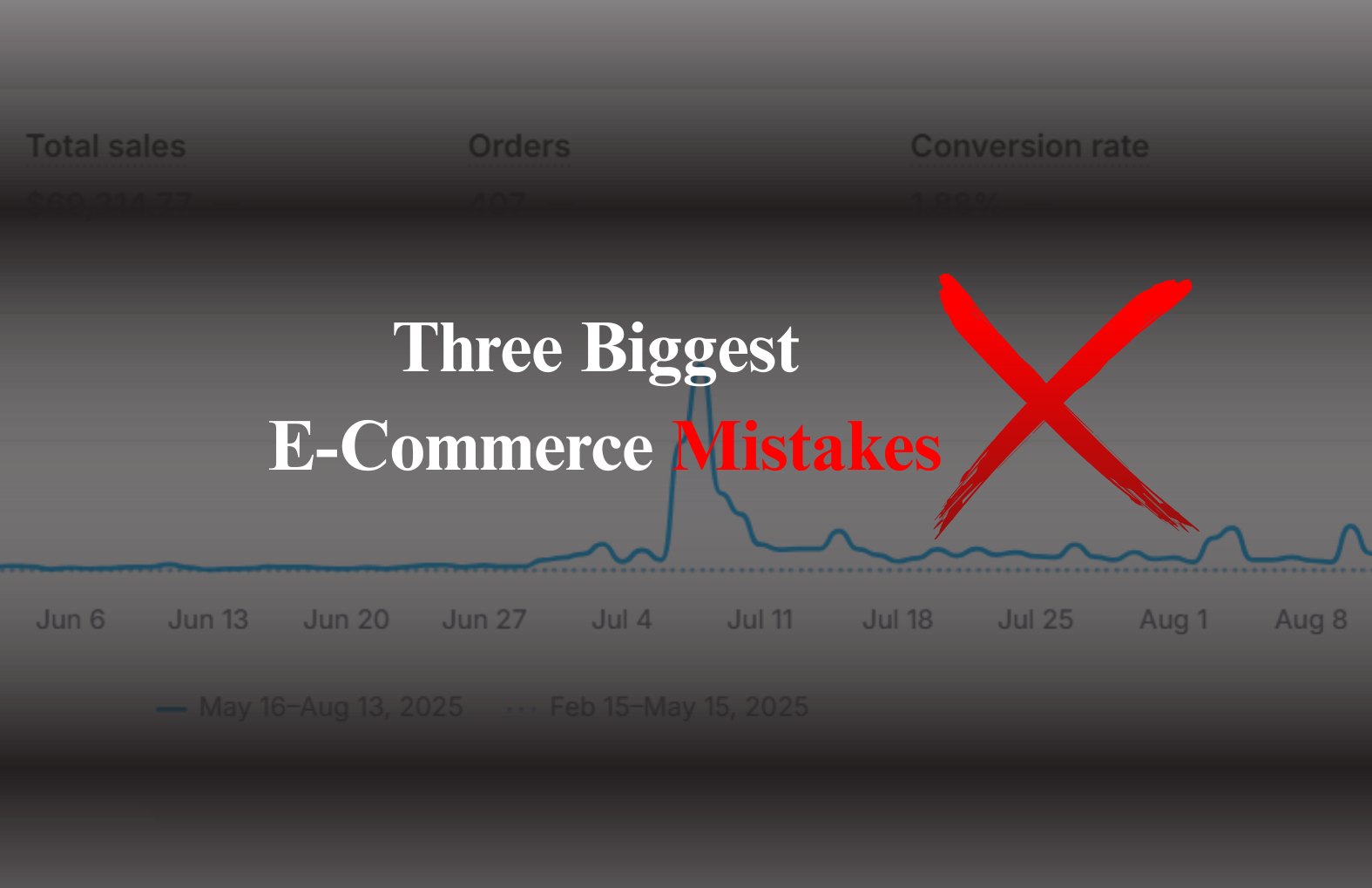
Three Biggest E-commerce Mistakes That Are Killing Your Conversions
Running an online store in 2025 is full of potential, but also full of traps.
Platforms like Shopify have made it incredibly easy to launch a professional-looking e-commerce website in just a few hours. You can pick a theme, upload your products, set up payments, and start selling, all without writing a single line of code.
But here’s the reality: over 90% of e-commerce businesses fail, and most of them are built on platforms like Shopify, WooCommerce, or Amazon. Why? Because having the right tools doesn’t automatically mean you’ll use them effectively.
In this article, we’ll break down the three biggest e-commerce mistakes that are silently killing your conversions and keeping your e-commerce store, Shopify or otherwise, from reaching its true potential.
1. Lack of Knowledge
The first and most common reason for e-commerce failure is lack of knowledge.
Many first-time store owners open a Shopify store because they’ve seen others succeed, but they underestimate the learning curve.
Here’s how this plays out:
- No clear target audience: If you don’t know exactly who you’re selling to, your ads, product descriptions, and overall store branding will be too generic to connect with anyone.
- Not using Shopify’s analytics: Shopify gives you powerful reports on traffic, sales, and customer behavior, but many sellers ignore them. Without data-driven decisions, you’re flying blind.
- Falling behind on trends: E-commerce changes fast. From AI-powered product recommendations to new Shopify apps for upselling, staying updated is essential.
Solution:
Treat your Shopify store as a real business. Learn about niche selection, product research, SEO, and conversion optimization before investing heavily. Shopify itself offers free courses through Shopify Academy, and there are countless resources to help you gain the right knowledge.
2. Lack of Practical Application
Knowing the theory is not enough execution is what drives results.
A lot of store owners binge-watch tutorials or attend webinars, but never take consistent action.
This is especially common with Shopify sellers who install dozens of apps and tweak their theme endlessly, but delay actually marketing their products.
Examples of this mistake include:
- Watching a Facebook Ads tutorial but never launching the campaign.
- Reading about product page optimization but never updating product images or copy.
- Learning about Shopify’s abandoned cart emails but never activating them.
Solution:
Make implementation a habit. If you learn something new — apply it the same week. For example:
- Add high-quality images to your Shopify product pages.
- Enable Shopify’s automated abandoned cart recovery emails.
- Test at least one paid campaign to bring in targeted traffic.
E-commerce success isn’t about doing everything perfectly from the start, it’s about taking action, testing, and improving.
3. Lack of Investment
The third major reason e-commerce businesses fail is lack of investment, in money, time, and tools.
Many entrepreneurs hope to build a profitable Shopify store with a “zero-budget” approach. While you can technically start small, scaling without investment is nearly impossible.
Why under-investing hurts your Shopify store:
- Poor branding: Low-quality logos and product images make customers doubt your legitimacy.
- Minimal marketing: Without a budget for ads, influencer marketing, or SEO, your store will struggle to get enough visitors to generate consistent sales.
- No product testing: Successful Shopify sellers test multiple products and ad creatives. This requires capital.
Solution:
Plan your budget before you launch. Even with Shopify’s low monthly fee, you should allocate funds for:
- Paid advertising (Google, Facebook, Instagram, TikTok)
- Professional product photography
- Shopify apps that boost conversions (upsell, reviews, email marketing)
Why These Mistakes Kill Your Shopify Conversions
Conversions aren’t just about traffic, they’re about turning visitors into customers.
- Lack of knowledge = You don’t understand your customer or how to position your offer.
- Lack of application = You never fully execute strategies that could generate sales.
- Lack of investment = Your store isn’t equipped to compete in today’s fast-paced online market.
Even if you have a visually appealing Shopify store, these biggest e-commerce mistakes can silently drain your conversion rate and make scaling nearly impossible.
Final Thoughts
Shopify gives you the tools, but how you use them determines your success.
If your store is struggling to make sales, ask yourself:
- Do I truly understand my target audience and market?
- Am I applying what I’ve learned consistently?
- Have I invested enough in marketing, branding, and product testing?
Fix these three biggest e-commerce mistakes, and you’ll put yourself ahead of the majority of failing stores.
Need help finding out why your Shopify or e-commerce store isn’t converting?
Click the link below and book a free consultancy session. We’ll review your store, identify the mistakes, and give you a step-by-step action plan to boost conversions.
Read Also: Why Selling Digital Products on Shopify is More Profitable in 2025
